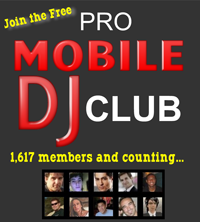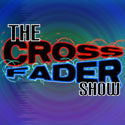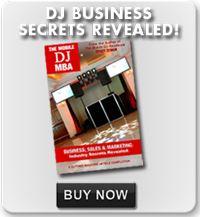by Dave Austin
 I overheard a veteran DJ ask for a definition of dubstep, and like many of us who are predominately wedding DJs, he’s heard the term but doesn’t really know what actually defines a dubstep music track.
I overheard a veteran DJ ask for a definition of dubstep, and like many of us who are predominately wedding DJs, he’s heard the term but doesn’t really know what actually defines a dubstep music track.
As with many musical genres, it’s sometimes difficult to clearly identify an evolving, moving target, but let’s give it a try.
Briefly, dubstep is a genre of electronic dance music that originated in London, England, about 1998. Its sound has been described as “tightly coiled productions with overwhelming bass lines and reverberant drum patterns, clipped samples and occasional vocals.” Whew!
Early dubstep releases were dark, experimental and mostly instrumental mixes of 2-step garage tracks which attempted to incorporate the funky elements of breakbeat and drum & bass. Rhythms were usually syncopated in the range of 138-142 BPM, with a clap or snare on every third beat. Soon, key producers began using the half-step rhythm which has become a signature of the genre. Dubstep rhythms typically don’t follow the “four-to-the-floor” pattern common in other styles of electronic music, but rely on longer percussion loops. Often, a track’s percussion follows a pattern which, when heard alone, will seem to be playing at half the track’s tempo – the double-time feel is instead achieved by other elements, usually the bassline.
One characteristic of certain strands of dubstep is the wobble bass, where an extended bass note is manipulated by using a low frequency oscillator. The resulting sound is a timbre punctuated by rhythmic variation in volume, filter cut-off and distortion. (Listen to Britney Spears’ “Freakshow” below) This style of bass is a driving factor in some variations of dubstep – particularly in club-friendly tracks.
The influence of dubstep on more mainstream genres can be identified as far back as 2007, but in 2009, it picked up steam and jumped onto the worldwide dance scene with the assimilation of elements of the sound into other genres. As the year began, the UK electronic duo La Roux dropped their single “In for the Kill” into the remixing hands of Skream, then “I’m Not Your Toy” to Nero and their single “Bulletproof” being remixed by Zinc.
A key factor in dubstep’s rise was its exposure on video sharing websites (YouTube, etc.) The sound also continued to pique the interest of the mainstream press with key articles in magazines like Interview, New York and The New York Times newspaper.
Endorsement quickly followed from R&B, hip-hop, and recently, mainstream figures like Rihanna, Public Enemy’s Hank Shocklee and Snoop Dogg who collaborated with producers Chase & Status, providing the vocal for their ‘underground anthem’ “Eastern Jam.”
Throughout 2010, dubstep began to hit the pop charts with Magnetic Man’s “I Need Air” which
reached #10 on the UK singles chart. These days, dubstep remixes of pop tunes are a must for many artists. Among these are Britney Spears’ “Freakshow,” LMFAO’s “Party Rock Anthem,” Maroon 5’s “Moves Like Jagger” and Far East Movement’s “Like a G 6”
Punctuating the growing popularity of dubstep, Sonny Moore, aka Skrillex, has become the first-ever dance artist to be nominated for a Best New Artist Grammy. He also garnered four additional noms for Best Dance Recording, Best Dance/Electronica Album, Best Remixed Recording and Best Short-Form Music Video.
Lately, the term “post-dubstep” is being used to describe music that combines the features of dubstep with other musical influences. I rather agree with writer Martin Clark who observed that “…attempts to loosely define the ground we’re covering here are somewhat futile and almost certainly flawed. However, given the links, interactions and free-flowing ideas…you can’t dismiss all these acts as unrelated.” That sounds rather clinical but it goes along with my earlier “moving target” reference.
Having listened to some of these tracks, I’m sure you’ll agree that dubstep is not for everyone. It appeals to a younger, hipper and musically savvy audience who take their dancing and partying seriously. If you’re fortunate enough to find yourself at a gig with the right crowd, drop some dubstep tracks and you may just grin yourself silly as you watch your dance floor go ballistic.
Dave Austin – Music Professor
Dave Austin began his career at age 13 at a small, hometown radio station. He went on to graduate from the University of Southern Mississippi with a Bachelor’s degree in broadcasting.
Since that time, Dave has been a mobile and radio DJ, radio station Program Director, and a TV news reporter and anchorman. He has also done voiceover work for documentaries and commercials.
In 1986 Dave’s longtime passion for music prompted him to start “Southern Celebrations DJs,” a multi-system mobile entertainment company serving clients in Tennessee, Northern Georgia and Northern Alabama.
You can email him c/o [email protected] or visit his website – Moonlight Mobile Music.











